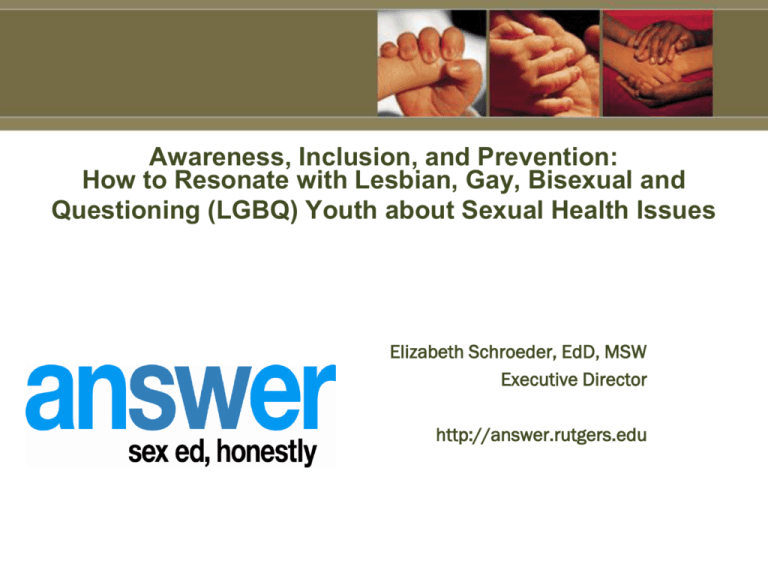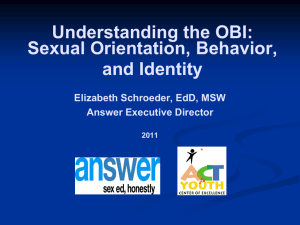
Awareness, Inclusion, and Prevention:
How to Resonate with Lesbian, Gay, Bisexual and
Questioning (LGBQ) Youth about Sexual Health Issues
Elizabeth Schroeder, EdD, MSW
Executive Director
http://answer.rutgers.edu
-Magazine for high
school students
-3 issues per year
-Comes with two free
lesson plans per issue
-Subscribe at
www.sexetc.org
25,000 unique visitors every day!
Training Institute in Sexual Health
Education (TISHE)
For middle and high
school education
professionals
August 9-14, 2009
40 hours of PD
credits
Professional Development in Yer Pajamas!
Two-Part Webinar Objectives:
• Describe at least 3 ways of adapting prevention and care
programs to be more inclusive of LGBQ youth.
• Identify at least 2 ways of addressing HIV prevention
that resonate with LGBQ youth.
• Name at least 2 strategies that participants will be able
to integrate into their own work.
• List at least 2 ways in which participants can address
this topic in a conservative social and/or political
climate.
Two-Part Agenda
Part One:
• Defining terms:
Where’s the “t”?
• Understanding
language/how LGBQ
folks are ignored
• Case studies/problem
solving
Part Two:
• How do I use this info
in my own work?
• Case studies/problem
solving
• Identifying steps for
being more inclusive
“Yellow Flag” Language
• “Yellow Flag” = “caution”
• Language re: sexual orientation that we may
need to think twice about
• Opportunity for psychoeducation
• Not punitive – is a teaching aid
“Yellow Flag” Language Examples
What is “Sexual Orientation”?
• Often make assumptions that youth understand
a commonly-used term
• High school senior: “Like any other
orientation…”
• Encourage a definition that includes the
following:
What is “Sexual Orientation”?
“The gender(s) of the people to
whom we are attracted, physically
and romantically”
What is “Sexual Orientation”?
“The gender(s) of the people to whom we are attracted,
physically and romantically”.
Two things of note:
• Includes more than one gender
• Includes romantic love: can know one’s orientation
without necessarily doing something sexual with
another person
Current Categories for Sexual Orientation
• Heterosexual
• Queer
• Lesbian or Gay
• Others???
• Bisexual
Understanding Bisexuality
• What is often said about bisexual people?
•
•
•
•
•
•
Are confused
Want the best of both worlds
Are greedy
Always have a date on a Saturday night
Can’t make up their minds
Have to date someone male and someone female
at the same time
• Are really gay, just don’t want to admit it
Bisexual:
A person for whom, when it
comes to sexual attraction,
gender is not necessarily the
defining factor
For Example…
• A heterosexual man walks into a room full of people
seeking a partner: Rules out men instantly
• A heterosexual woman walks into a room full of people
seeking a partner: Rules out women instantly
• Bisexual person: walks into a room full of people
seeking a partner – doesn’t rule out anyone instantly
based on gender
This is important because…
• Many people identify as bisexual before accepting being
gay/lesbian.
• Bisexuality most misunderstood – and least often
mentioned – orientation.
• Bisexual youth often underestimate HIV/STD risk
because have “one foot in” heterosexuality.
And you may ask yourself… well, how did I
get here?
Kinsey and the Kinsey Scale…
|---------|---------|--------|--------|---------|---------|
0
1
2
3
4
5
6
0 = Exclusively Heterosexual
6 = Exclusively Lesbian or Gay
3 = Bisexual
What Kinsey Found Was…
Most People were:
|---------|---------|--------|---------|---------|--------|
0
1
2
3
4
5
6
HERE
or HERE
How We Use This Info Today…
|---------|---------|--------|---------|---------|--------|
0
1
2
3
4
5
6
Orientation = to whom are we attracted?
Behavior = with whom are we engaging in
sexual acts?
Identity = what do we call ourselves?
|---------|---------|--------|---------|---------|--------|
0
1
2
3
4
5
6
O
B
I
A woman who is attracted (orientation) exclusively to men: 0
Will likely be sexual (behavior) only with men: 0
Will likely call herself (identity) heterosexual: 0
But it’s not always that
clear cut…
Example One
• Woman who has always identified as
lesbian – only ever been attracted to
women, only ever been sexual with
women. Clear Kinsey 6.
• A few years ago, met, fell in love with, and
married a man with whom she is
monogamous.
Trick Question!
When it comes to identity
(what one calls oneself)
we have to ASK the person.
Is an INSIDE OUT process
Mapping Example One
|---------|---------|--------|---------|---------|--------|
0
1
2
3
4
5
6
O
B
Attracted primarily to this ONE man: Very close to 6
She is currently only sexual with this one man: 0
What does she call herself? (We asked!)
Mapping Example One
|---------|---------|--------|---------|---------|--------|
0
1
2
3
4
5
6
O
B
I
She identifies as “lesbian”
(Reactions?)
Example Two
• Teen male who has always identified as
heterosexual and has always been only with
girls. Clear Kinsey 0.
• Was arrested and placed into juvenile detention
for two years, where he had sexual relationships
with several males.
• Where are his O, B and I?
Remember – it’s a trick question!
We have to ask him.
But let’s map it out on the
Kinsey Scale…
Mapping Example Two
|---------|---------|--------|---------|---------|--------|
0
1
2
3
4
5
6
O
B
Don’t know whether attracted to men – but if asked?
Is currently sexual only with guys -- circumstantial: 6
What does he call himself? (Ask him!)
Example Three: “The Down Low”
• Adult male who has a female partner/spouse.
Identifies as heterosexual.
• When he goes to play card with his male friends,
two of the guys, including him, will disappear
into bedroom and have sex.
• Where are his O, B and I?
Remember – it’s a trick question!
We have to ask him.
But let’s map it out on the
Kinsey Scale…
Mapping Example Three
|---------|---------|--------|---------|---------|--------|
0
1
2
3
4
5
6
O
B
His “O” is hard to graph: could be anywhere
Is currently sexual with several guys, one woman: B?
What does he call himself? (Ask him!)
Remember…
• Identity trumps Behavior and Orientation
• Is an inside out process, NOT outside in
• What you do sexually does not necessarily
define who you are
Implications for HIV prevention work
• Closeted identity leads to unsafe/closeted
behaviors: Safer sex issues
• Screening through the OBI: BEHAVIOR is
focus
• Double standard: gender
Double Standard: Gender
• Homophobia much stronger against males
• Two girls together: “That’s hot!” (as long
as gender congruent)
• Myth: “No such thing as male bisexuality”
Some data specific to girls…
• CDC survey: more female high school and
college students “experimenting” with other
women than ever before.
• Girls don’t think they need to practice safer
sex when with other girls (HIV but HPV)
Being Inclusive in HIV Prevention Education
We tend to…
1. Have one lesson/
separate section on HIV
issues for LGBQ
2. Talk about risks for
“homosexuals” or “gays”
We should…
1. Do this – BUT also
include examples
throughout
2. Be specific. Lesbian is
different from gay,
bisexual, etc.
Being Inclusive in HIV Prevention Education
We tend to…
3. Think identity puts at risk
We should…
3. Remember behavior is what
puts at risk
4, Use the term “partner” in an
effort to be gender-neutral
and inclusive
4, Be specific. “Boyfriend” and
“Girlfriend”… when
possible…
5. Talk about how hard it is to be
LGB
5. Provide examples of sexually
healthy LGB relationships
Being Inclusive in HIV Prevention Education
We should…
We tend to…
6. Focus on one type of 6. Remember diversity
w/in diversity
diversity at a time
7. Teach as if our entire 7. Model inclusion
throughout
audience were
heterosexual
Activity: Making A Lesson More Inclusive
• What are positive efforts made in each?
• What can each do differently?
Example One: A Case Study
“Jared and Maria have been together for several
months. They don’t know about each other’s
sexual histories, but both assume the other has
never had sex (or at least unprotected sex) with
anyone else. Recently, their kissing sessions
have gotten more "involved." They haven’t
talked about it yet, but they are both interested
in having sex — sexual intercourse that is.”
• What positive efforts are made viz.
inclusion?
• What could it do differently?
Some Suggestions…
• More than one case study
• Gender-neutral names
• “Sex”; “Sexual intercourse” = “vaginal
intercourse”: alternate behavior?
• In mentioning sexual histories, mention
“or the gender(s) of the people with whom
they’ve been sexual”
Example Two: An HIV Quiz Excerpt
1. Only homosexual men, injecting drug
users and prostitutes can be infected
with HIV.
6. You can become infected with HIV
when you have unprotected
intercourse one time only with an HIVinfected person.
2. The AIDS virus attacks the body's
defense system and makes a person
vulnerable to other infections.
7. Married people can become infected
with HIV.
3. You can become infected with HIV
when you have unprotected anal sex.
8. You can be infected with HIV and not be
aware of it.
4. HIV can be transmitted through oral
sex.
9. Condom use reduces the risk of HIV
infection.
5. If you are seronegative it means that
you are immune to HIV.
10. Women who use the birth-control pill
can become infected with HIV.
• What positive efforts are made viz.
inclusion?
• What could it do differently?
Some Suggestions…
• “Gay or bisexual” vs. homosexual
• “Unprotected intercourse”
• “Married people” “People in
monogamous relationships” or “People in
long-term committed relationships”
• “Condom” or “latex dam” use
Take home messages when choosing
activities for teaching re: HIV
• Look at names of characters
• Look at behaviors
• Look at relationships
• Look for stereotype propagation
• Review and revise when possible
Questions?






